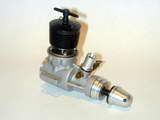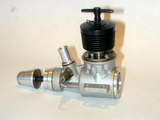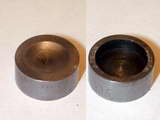| Name | Taipan Series 13 | Designer | Gordon Burford |
| Type | Compression Ignition | Capacity | 2.5cc |
| Production run | unknown | Country of Origin | Australia |
| Photo by | Ron C | Year of manufacture | 1972 |
Background
As long-time readers of these pages will know, I have two mildly debilitating fetishes: Twins and Taipans. The latter is explained by fond childhood memories of my first engine which led to an affection for the range. Strangely, my collection contains relatively few examples of both fixations, but I'm drawn towards them nevertheless. So when I was contacted (as President of Model Engine News dot org) to help the owner of a Taipan in need of repair, I found myself conflicted. The engine needed a new contra-piston (a long story). This would have to be custom made, and at any charge rate that accounts for the time involved, would result in a cost greater than the worth of the engine. On the other hand, it was a Taipan; how could I refuse? So the engine was restored to fully operational at a cost that both the owner and I could live with, and the world has another running Taipan.
During the email exchange, I was asked about the history of this engine and having a new one in my own meagre collection, decided it would be a good "Engine of the Month" subject. At the same time, another email arrived from a lucky bloke who'd picked up a Sabre diesel at a flea market. The new owner knew of the Sabre/Taipan connection and suggested the story would make good reading for these pages. Being a bit light on for news, this sounded like a great idea, especially as it dove-tailed with the subject chosen for review. So before looking at the Lucky Last Series 13 Taipan 2.5 TBR, let's travel back to the ninteen-fifties for a David and Goliath story (in which the giant wins for a change).
Gordon Burford and the Sabre
 Gordon Burford (second from the left in this picture taken in the MEN Library) has been a household name in Australian modelling circles (pun) since about forever. Born on August 3, 1919, Gordon was bitten by the aeromodelling bug at an early age. Economic times being what they were while Gordon was growing up during the Depression, owning an engine was beyond his reach, but this in no way diminished his attraction to them.
Gordon Burford (second from the left in this picture taken in the MEN Library) has been a household name in Australian modelling circles (pun) since about forever. Born on August 3, 1919, Gordon was bitten by the aeromodelling bug at an early age. Economic times being what they were while Gordon was growing up during the Depression, owning an engine was beyond his reach, but this in no way diminished his attraction to them.
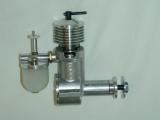 During WWII, Gordon was classified as "skilled personnel" and put to work as an automatic pilot instrument mechanic [1], further refining his skills as a machinist. So when the Sparey 5cc diesel plans appeared in the May 1946 issue of English magazine Aeromodeller, Gordon made three engines based around the design. The story of how these were lost, and how, more than 50 years later, one was found and returned to Gordon by our own Bert Streigler, was recounted by Motor Boy, David Owen in Model Engine World, 1997 [2]. Gordon and David later collaborated on a faithful reproduction of this engine, seen here.
During WWII, Gordon was classified as "skilled personnel" and put to work as an automatic pilot instrument mechanic [1], further refining his skills as a machinist. So when the Sparey 5cc diesel plans appeared in the May 1946 issue of English magazine Aeromodeller, Gordon made three engines based around the design. The story of how these were lost, and how, more than 50 years later, one was found and returned to Gordon by our own Bert Streigler, was recounted by Motor Boy, David Owen in Model Engine World, 1997 [2]. Gordon and David later collaborated on a faithful reproduction of this engine, seen here.
 In 1947, Gordon launched his first production engine, the Gee Bee Stunt-Mota. The "Gee Bee" would have resonated with air-minded modellers from the famous racing plane, as well as being Gordon's initials. Based on the fixed compression, US made Drone diesel, about 250 examples of the Stunt-Mota were produced (just love that name by the way
In 1947, Gordon launched his first production engine, the Gee Bee Stunt-Mota. The "Gee Bee" would have resonated with air-minded modellers from the famous racing plane, as well as being Gordon's initials. Based on the fixed compression, US made Drone diesel, about 250 examples of the Stunt-Mota were produced (just love that name by the way  ). Other models followed, both glow and variable compression diesel. The machinations of wily Australian entrepreneur, Bill Evans, forced Gordon to abandon the Gee Bee name, so in late 1950, he introduced a new range of glow and diesel engines under the name "Sabre" [3].
). Other models followed, both glow and variable compression diesel. The machinations of wily Australian entrepreneur, Bill Evans, forced Gordon to abandon the Gee Bee name, so in late 1950, he introduced a new range of glow and diesel engines under the name "Sabre" [3].
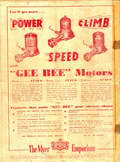 Gordon applied to register "Sabre" as a Trade Mark in April 1952 [4]. Government bureaucracy being what it is, the application was finally Gazetted in November 1955, allowing a period of three months for objections. What followed is so well stated by Ivor F in reference [4] that I'll simply quote him verbatim:
Gordon applied to register "Sabre" as a Trade Mark in April 1952 [4]. Government bureaucracy being what it is, the application was finally Gazetted in November 1955, allowing a period of three months for objections. What followed is so well stated by Ivor F in reference [4] that I'll simply quote him verbatim:
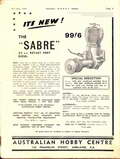 On 9th February 1956, eight days before the deadline for objection to Gordon Burford's application No. 109664, a firm of Patent and Trade Mark Attorneys (delightfully Dickensian phrase) sent Burford a letter on behalf of their principals advising that an extension of time to lodge an objection was being sought. The letter also advised that the firm of Spruson and Ferguson were in receipt of instructions to demand that you will withdraw application 109664 and give an undertaking not to use the trade mark on model internal combustion engines for model aircraft, cars, and boats, in as much as such use could deceive and confuse the purchasing public (that's you, you stupid gullible engine buyers) into believing that they were products of North American Aviation Inc. or their permitted users in Australia, Commonwealth Aircraft Corporation Ltd.
On 9th February 1956, eight days before the deadline for objection to Gordon Burford's application No. 109664, a firm of Patent and Trade Mark Attorneys (delightfully Dickensian phrase) sent Burford a letter on behalf of their principals advising that an extension of time to lodge an objection was being sought. The letter also advised that the firm of Spruson and Ferguson were in receipt of instructions to demand that you will withdraw application 109664 and give an undertaking not to use the trade mark on model internal combustion engines for model aircraft, cars, and boats, in as much as such use could deceive and confuse the purchasing public (that's you, you stupid gullible engine buyers) into believing that they were products of North American Aviation Inc. or their permitted users in Australia, Commonwealth Aircraft Corporation Ltd.
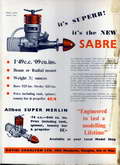 To cut a long story short, while the case was laughable and probably winable, the cost would have destroyed him. So Gordon capitulated and for a time, his engines were unbranded. To rub salt into the wound, in November 1955, the same month that Gordon's three-and-a-half year old Trade Mark application was finally Gazetted, Aeromodeller carried an inside cover advertisement for the new Davies Charlton Allbon Sabre! DC could hardly be unaware of prior use of this name as the GEE-BEE (sic) SABRE 250 Diesel had been the subject for Lawerence Sparey's Engine Analysis Number 35 in the May 1951 issue of the Aeromodeller. DC were never challenged over this usage, nor by Supermarine for applying the name Spitfire to another of their diesels. Maybe the tribulations Gordon suffered arose from the diligence which the Australian attorneys for the Commonwealth Aircraft Corporation exerted to protect their client from potential loss, presumably for an appropriate fee.
To cut a long story short, while the case was laughable and probably winable, the cost would have destroyed him. So Gordon capitulated and for a time, his engines were unbranded. To rub salt into the wound, in November 1955, the same month that Gordon's three-and-a-half year old Trade Mark application was finally Gazetted, Aeromodeller carried an inside cover advertisement for the new Davies Charlton Allbon Sabre! DC could hardly be unaware of prior use of this name as the GEE-BEE (sic) SABRE 250 Diesel had been the subject for Lawerence Sparey's Engine Analysis Number 35 in the May 1951 issue of the Aeromodeller. DC were never challenged over this usage, nor by Supermarine for applying the name Spitfire to another of their diesels. Maybe the tribulations Gordon suffered arose from the diligence which the Australian attorneys for the Commonwealth Aircraft Corporation exerted to protect their client from potential loss, presumably for an appropriate fee.
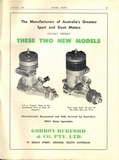
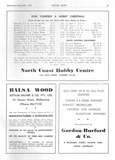 Anyway, after a no-name period, Gordon settled on Glow-Chief for his glow engines, and Taipan for the diesels [5]. Makes sense to me, and the distinction is clearly inferred from the advertisement appearing Model News of November-December, 1957. Lamentably, a later ad in the same publication from 1962 clearly shows the Taipan 2.5cc glow. Argghhh!
Anyway, after a no-name period, Gordon settled on Glow-Chief for his glow engines, and Taipan for the diesels [5]. Makes sense to me, and the distinction is clearly inferred from the advertisement appearing Model News of November-December, 1957. Lamentably, a later ad in the same publication from 1962 clearly shows the Taipan 2.5cc glow. Argghhh!
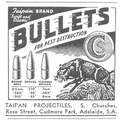 To close off the branding story, the name Taipan survived, although not without one last speed-bump encounter. Seemingly no sooner had Gordon launched the name in 1957, when he was contacted by the proprietor of Taipan Projectiles regarding prior use of the name. Talk about here we go again--Gordon could probably be excused for thinking his karma must have run over the Lord's dogma. Happily, the maker of Taipan Projectiles (for pest destruction--designate your own pest) turned out to be a most reasonable bloke. So Gordon promised in writing that, out-of-control models aside, he had no intention of ever making anything connected with ballistic projectiles, and no more was said.
To close off the branding story, the name Taipan survived, although not without one last speed-bump encounter. Seemingly no sooner had Gordon launched the name in 1957, when he was contacted by the proprietor of Taipan Projectiles regarding prior use of the name. Talk about here we go again--Gordon could probably be excused for thinking his karma must have run over the Lord's dogma. Happily, the maker of Taipan Projectiles (for pest destruction--designate your own pest) turned out to be a most reasonable bloke. So Gordon promised in writing that, out-of-control models aside, he had no intention of ever making anything connected with ballistic projectiles, and no more was said.
Description
Back to the subject--that's the Series 13 Taipan 2.5cc twin ball race diesel in case you've forgotten. Identifying which Taipan is what is not an easy task. Changes from one year to another range from dramatic through subtle, to none at all, and as advertising was sporadic in Australia's only model magazine of the time, references for comparison are hard to find. Luckily, Ivor F wrote the definitive story of the 2.5cc Taipan diesels for an article that appeared in Airborne of December 1978 [6]. From this, the engine is easily identified as being from the last series produced in 1972. While it shares a similarity to the 12th series model (known as the Series 70, produced in 1969), the black anodized head with the wire compression screw friction device, subtle case and prop driver differences, plus the spinner nut and parallel sided venturi make identification unambiguous.
Reference [6] makes it plain that there were 13 "series" of Taipan 2.5cc diesel engines, with an occasional "Mk II" of some model appearing to cloud the issue--plus "variants" which introduce a quantifiable change without any designation revision, not to mention the marine versions! However, we can call this one a twin ball race, front rotary induction, compression ignition engine with Arden porting (two transfer channels milled inside the liner, fore and aft). The liner attaches to the die cast crankcase with four metric thread screws. The cooling jacket threads onto the hardened steel liner. Piston and contra-piston are turned from cast iron. The piston is flat-topped, while the contra-piston has a light hemispherical depression milled into the center to provide a wide squish-band, as seen here.
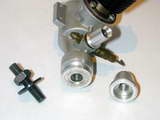 Australian conditions are harsh, which is to say the countryside is largely dry with accompanying dust and hard-baked, unforgiving ground. To withstand sudden arrivals, all Taipans were ruggedly made and in consequence, heavier than similar English models (where the challenge would have been being able to dig down far enough into the bog to retrieve the motor). To increase the crash resistance of his engines, Gordon's designs frequently incorporate a separate threaded stud that screws into the crankshaft, as seen here. Harking back to the first Gee Bees and Sabres, this allows a bent stud to be replaced for less cost than a bent shaft. The needle valve was quite conventional on this engine, and was fitted with a one sided, stainless steel ratchet. Gordon told me that the die to punch and form these clickers was the most expensive piece of tooling ever produced for any part of the entire Taipan range.
Australian conditions are harsh, which is to say the countryside is largely dry with accompanying dust and hard-baked, unforgiving ground. To withstand sudden arrivals, all Taipans were ruggedly made and in consequence, heavier than similar English models (where the challenge would have been being able to dig down far enough into the bog to retrieve the motor). To increase the crash resistance of his engines, Gordon's designs frequently incorporate a separate threaded stud that screws into the crankshaft, as seen here. Harking back to the first Gee Bees and Sabres, this allows a bent stud to be replaced for less cost than a bent shaft. The needle valve was quite conventional on this engine, and was fitted with a one sided, stainless steel ratchet. Gordon told me that the die to punch and form these clickers was the most expensive piece of tooling ever produced for any part of the entire Taipan range.
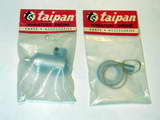 Optional accessories for the Series 12 and 13 Taipan 2.5 was this light weight, die cast exhaust collector ring and matching muffler. The collector ring appears to have been standard equipment for the marine version (sensible when you think about it). The muffler is a simple expansion type that would have been adequate for the days when the first stirrings of noise complaints against our past-time were being felt.
Optional accessories for the Series 12 and 13 Taipan 2.5 was this light weight, die cast exhaust collector ring and matching muffler. The collector ring appears to have been standard equipment for the marine version (sensible when you think about it). The muffler is a simple expansion type that would have been adequate for the days when the first stirrings of noise complaints against our past-time were being felt.
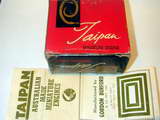 The Series 13 was supplied in a substantial, reinforced cardboard box. The accompanying instruction leaflet was quite general in nature, covering the 1.9cc plain-bearing "Tyro", the 2.5cc TBR, and the plain-bearing 3.5cc glow. The instructions also covered the adjustment of the optional R/C throttle assembly. Prominent in the Starting and Running-In section is an admonition against clamping the engine itself in a vice ("ON NO ACCOUNT..."). Not hard to see that Taipan must have received more than one or two engines for repair that has been subjected to this indignity.
The Series 13 was supplied in a substantial, reinforced cardboard box. The accompanying instruction leaflet was quite general in nature, covering the 1.9cc plain-bearing "Tyro", the 2.5cc TBR, and the plain-bearing 3.5cc glow. The instructions also covered the adjustment of the optional R/C throttle assembly. Prominent in the Starting and Running-In section is an admonition against clamping the engine itself in a vice ("ON NO ACCOUNT..."). Not hard to see that Taipan must have received more than one or two engines for repair that has been subjected to this indignity.
Conclusion
Although Taipan continued to produce ever finer (and larger) engines for several years until Gordon retired and closed the doors, the Series 13 marks the last of the diesels--which are to me the quintessential Taipans. To paraphrase a well worn quip: Ahhh, the smell of diesel in the morning; nothing like it!References:
| [1] | F, Ivor: Australian Production Motors, Model Engine World, Barton Model Products, Volume 4, Issue 4, Number 40, August 1997, p17 (reprinted from an article series of the same name appearing in Australian Modeller, Issue 7, 1969). |
| [2] | Owen, David: View From Downunder, Model Engine World, Barton Model Products, Volume 4, Issue 7, Number 43, November 1997, p6. |
| [3] | F, Ivor: Australian Production Motors, Model Engine World, Barton Model Products, Volume 4, Issue 6, Number 41, September 1997, p16. |
| [4] | F, Ivor: Australian Production Motors, Model Engine World, Barton Model Products, Volume 4, Issue 6, Number 42, October 1997, p15. |
| [5] | F, Ivor: Australian Production Motors, Model Engine World, Barton Model Products, Volume 4, Issue 7, Number 43, November 1997, p15. |
| [6] | F, Ivor: The Taipan 2.5 Diesel Story, Australian Airborne Magazine, Number 29, December 1978, p41. |
![]()
